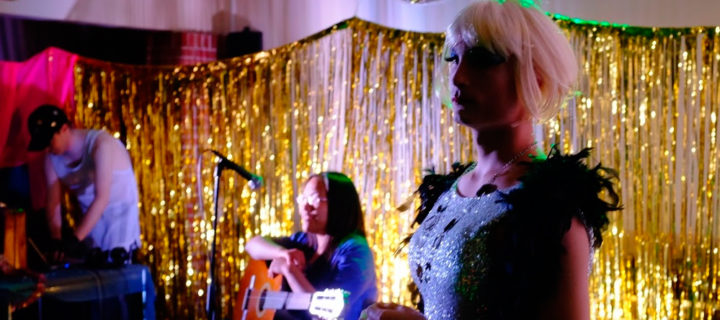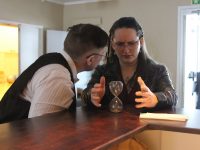Larping while Queer
Who’s a Queer
I guess everybody knows I’m gay, but I don’t think everybody knows I’m a queer, too. I like to incorporate gay culture into my speech and slang, and even used to flaunt my gayness, but I haven’t been able to come to grips with being queer.
Being queer is to approach life from an oblique angle, to step into the world somehow askance, as an outsider, which is decidedly more difficult (Ahmed 2006, passim). Being left-handed must feel similar. There are all these scissors and tools and techniques out there that everybody can just grab and use, but for you, there’s something amiss. You can’t get a proper hold even if you know perfectly how people go about it. They just pick up the scissors and don’t give any thoughts to the fact that they’re custom-built to suit their take on the world.
It’s the same for queers as it is for lefties. You find the world wasn’t designed with you in mind. Straight love stories feel like wrong-handed scissors to me. I understand perfectly well – intellectually – what they’re about, but they aren’t immediately accessible to me. I can pick them up and use them, but only awkwardly. Their straightness is foregrounded. I guess stories that happen in queer settings must feel the same for straight people. Guess that’s why they always call them gay love stories. Brokeback Mountain isn’t about cowboys in love; it’s about gay cowboys in something that looks an awful lot like love (except without the emotional impact.)
Until I played Just a Little Lovin’ this summer (2015), I never understood why straight people were interested in playing love stories. It was abstract and I couldn’t relate to it.
The Gay Agenda
Once at the tender age of 16, a female player tried to involve me in a love plot at a Danish fantasy larp; I went along with the midnight moonlit walk in the woods, but felt alienated from the situation – somewhat worried that this would come across as off-game dating.
Since then love plots were only a source of potential awkwardness for me – either the awkwardness of feigning heterosexuality in-game, feigning interest in heterosexual love stories for fear of seeming unable to immerse, or – above all – the awkwardness I would risk if it looked as though I were steering my game in a romantic direction.
Imposing my queer agenda on the game for personal gratification seemed like the perfect way to become an outsider. When I was growing up in the Danish fantasy larp scene (c. 2000–2005), the games we played tended not to be accessible to players as queer people because they rarely or never incorporated queer themes directly.
It is not that people were homophobes; I just do not think it occurred to them that the king could be a big queen, that fierce lady orcs could love each other, or that gender transitioning could be a rite of passage for druids. Orcs were fine, but fairies stretch the imagination.
The only even remotely queer thing that comes to mind from that time are the cracks about homoelvere (gay elves). I was one, of course. I once received a letter in the post addressed to “Erik, the gayest boy in the world.” Bless the sender, who knows who he is, and bless my parents for not asking questions.
Any bona-fide queerness in the larp fiction would be something that I would have to introduce out of my own initiative. Maybe not at my own peril, but try telling that to a giddy kid who is only out of the closet when he is at larps. And does not want to fuck things up. What would it say about me if I could not even play a silly game without queerhacking it to accommodate my particular proclivities? When you go to a larp that is not designed for queerness, and you bring up the issue and pursue queer themes, it can feel as if you are imposing your queer agenda on the game. There are not many good reasons for a person to do such a strange thing. Either you are doing it for sexual kinks or you are trying to make a point of it. Other players might not have given any thought to whether there are queer characters in the game or even in the game world. It sounds like reasonable accommodation, but it feels a lot like rocking the boat.
Queens and Wizards
Two larps challenged that feeling. The first was close to home – the College of Wizardry (2015, 3rd run), a Harry Potter-esque game about the students and staff that has been making the headlines for the last couple of years.
I was not intending it to be, but College of Wizardry became queer larp bootcamp for me before I had to go full queer later in the year. It was the first larp I had been to where the organizers had specifically written the existence of queer relationships into the fiction – they dedicated a whole page of the design document (Rollespilsfabrikken 2015) to telling us it’s OK to play gay. I guess they provided an affordance that I have not been used to having. If they had not made that design decision, I probably would not have asked. I mean, there are kids there. Can’t I just get on with the game?
Luckily, that’s exactly what I got to do. Seeing as I am a larper and love to cry, I wanted to play a mournful widower whose husband had been “scraped off the wall and buried with honors” during the Wizarding Wars. Playing it straight would have been a distraction, would have made it less real. College of Wizardry was a place where the queerness of being gay could be left in the background, and I could just be an angry widower instead.
Nevertheless, my character was studiously asexual and churlish. Three co-players conspired to tame the shrew and get me out into the world again. I am sorry to say that they succeeded. Once again, I would not have done that on my own. A simple design choice from the organizers reminded me that queer stories were possible topics of play. I did still have to come out of the closet during the game, but that was because my character was an unregistered badger Animagus, not a gay widower.
And then there was Just a Little Lovin’, which has gotta be the gayest larp ever played. It is almost mythically so – leather men, drag queens, dark rooms, dykes, closet cases, AIDS, Abba, sequins, brotherhood, fisting. The aesthetics are camp and the theme is dead serious. Players portray a social circuit in New York in the 1980s as it is ravaged by AIDS during the years of 1982, 1983 and 1984. The stories that the larp produces are magnificent run after run after run, but for me and from what I know, the transformative part of the game is how it transplants players into a world where gay is the new normal. It was the best game I have ever played and I think that is true for a lot of other people, especially all the other queers.
Playing Out the Closet
You would think going to Just a Little Lovin’, the gayest game ever, would be a chance to let my queerness fade into the background. For one, it was my first experience of being in a gay male world outside “the scene” – where I had never felt at home, anyway. I think I am too square for it. Everybody always thinks I am somebody’s awkward straight friend. It sounds poetic, “being a stranger among my own kind”, but when you’re in the situation it just makes you feel even queerer. Finally, my gayness would not set me apart – just my queerness.
In daily life, it is hard to trace all of the sources of my queerness. As a geek, I am queered once talk goes to mainstream topics I cannot identify with, which I imagine a lot of larpers have experienced. As a perpetual foreigner, as someone who wanders into the deep end of conversations, I am queer for a lot of reasons. I might as well be left-handed.
After Just a Little Lovin’, I even felt some resentment toward straight players. They get to read and play love stories without all the mental adjustments, caveats, and hypotheticals that gay people need to make in order to relate to them. They get to cringe at and enjoy Hollywood sex scenes for what they are. They get to have their stories served up straight. The rest of us do not have that. It is like we are listening for love songs, but through heavy white noise. Straight people have got it coming in loud and clear.
In the context of Just a Little Lovin’, it was safe to assume that everyone was either gay or gay-friendly, and the straight characters were an amusing backdrop.
On the other hand, I was still a very queer character – older, a drag queen, mother, always donning an alter-ego that I could use as a shield. I could be aloof and statuesque if I wanted to, and every time anything became too real, I could escape into a world of my own making. My character, gay guy Nate, could become the Queen of Diamonds. He even escaped death (for a time).
While Just a Little Lovin’ did offer relief from a single source of my queerness, my orientation toward other men, it could not dispel my inclination. I did not go into the dark room nor participate in orgies. I only had three sex scenes, all of which involved straight players, and I still feel guilty about one of them and awkward about finding them all a bit arousing. Even in a gay larp, there are ways to feel like a big old queer.
My character’s story once again became a story about being drawn into the world and forced to unqueer myself – but I struggled to fully engage until I was literally grabbed by the hair in a sex scene and brought into the story, incidentally by a straight player, who I imagine has more experience being in the normal world and thus being more accustomed to love stories and play. I was a larp love virgin. For some players, queer had become so normal that they had trouble readjusting to the fact that most people in the world are not. That was not my experience – but I did get to forget my gayness and play around with being queer, and boy did I ever.
Queer Shame
Years before I played Just a Little Lovin’, I attended a workshop at Solmukohta 2012 where the sex simulation technique used at the game was demonstrated. Other people have described it better than I can:
Sexual scenes started with offering another player a pink feather[1]Not every sex scene in the Just a Little Lovin’ runs has played out like this. Feathers, for instance, are sometimes omitted in favor of diegetic negotiation. I myself am not sure I would have dared do without. For a more in-depth explanation, see Edland (2013).. If they took the feather then they said yes to playing a sex scene … If you did agree, you took the feather and you walked off a bit from the other players, talked out of character about what sort scene you wanted to do, agreed on how you were comfortable playing it and then you played the sex scene. When you played sex you could touch the other player, as long as you kept your clothes on, and as long as you didn’t touch genital areas and the breasts. … Penetrative sex and any other type of sex that might transmit the virus was played out by touching and stroking and playing with a phallic prop. Phallic prop.
It is hands-on. And it is a great technique, but it is also terrifying – which is why the organizers of Just a Little Lovin’ go to such efforts to couch it in narrative meaning, with a symbolic way of accepting or declining an invitation to have a sex scene, a detailed negotiation beforehand, monologues afterwards, and so on. It is not like you just whip it out and start larp-screwing people.
The workshop facilitator tried to explain all of this and made an honest effort to make people – me – feel safe about trying the technique, but it did not work. Through the combined efforts of somebody’s toddler being present, casual onlookers passing through the workshop space, and general feeling of exposure, I was doused with buckets of sexual shame that in a way I had not experienced since my Dad once forgot to knock. That is only context, though. What was the proximate cause of my shame? The exposure was bad enough. Worst was the fact that one of the mini-scenes was nice. I ended up snuggling up with a tall, dark and handsome French larper – though somebody older and different than the kind of guy I would usually go for – and stroking a candle. The candle did not do it for me, but the snuggling sort of did. Once again, the fear of exploiting the game situation for sexual gratification. Alongside a platinum wig and hooker shoes, that’s some of the luggage I packed for Just a Little Lovin’.
A Queer Beauty
My character at Just a Little Lovin’ was something of an alien. A one-time loner, drag queen, a man with a million pasts, who had swept into town six months before like Dionysus arriving from the east. In the game world, he had screwed his way through half of New York before setting up his nightclub. Par for the course.
For my own part, I could not see my character as very sexual. Being a gay man, appreciation of women’s beauty and desirability is abstract for me. I know what physical beauty looks like and what bodies are, so to say, attractive, but they do not actually do it for me. I can recognize attractiveness, but it does not arouse me. And although I love drag, I am not particularly attracted to men in drag. I like masculine guys, even though they can be intimidating.
I also like to think of myself as quite masculine and I dress to maximize that appearance. Even when I wear something more feminine, like a t-shirt with a low neckline, I do it to show off my male strength. The feminine has a strange allure, if only because we grow in a world where men are supposed to be attracted by femininity. It does not matter that you are gay, or that you are a man. Growing up in a culture where the masculine is drawn to the feminine, playing around with femininity feels like playing with fire. On the one hand, there is an excitement to it and some plain relief from not having to perform traditional masculinity; on the other, there is a shame from feminization and a fear of losing your attractiveness as a man, demeaning yourself by being a nancy boy.
The effeminate is a no-man’s land that you don’t venture into lightly. Even gay men can be bitches toward fems. I mean, nobody wants to be a sissy, right?
I had not been in drag since I did a rendition of Geri Spice at a school show in the 6th grade. Sassy is fine; sissy is not. The prospect of playing a drag queen was quite intimidating. And the physical sensation of dragging was strange and foreign, but did not come close to the experience of seeing myself full-figure in the mirror and hardly recognizing the visage looking back at me. Queer almost does not cover it. As I wrote a few days later:
Experiencing [Nate’s story] and creating it as a player gave me a taste of being beautiful and admired in a way I have never been before. It’s a foreign and different and dreamlike kind of beauty you feel as a drag queen of his time and age. It’s made me look at myself, literally, in a different light. (…) I got to stand as a statue and lie half-undressed, makeup smeared, and look at myself in that big, gorgeous mirror in the dressing room. It was bizarre and I don’t know how to square that image of myself with what I otherwise am. Nate might be someone I might have been, had I been born when he was. I don’t know how I feel about that. It feels dangerous and horrifying, but the appeal of his life and his aesthetic is still there.
For a straight player, reorienting themselves sexually and socially toward the same sex might have been a powerful source of personal queerness. For me, it was through drag.
I do not think your personal sexual desire toward a gender can be changed through a game, but I do think your orientation can be. For someone who is oriented toward men, whether sexually, romantically or socially, you read a room in a different way than someone who is “into” women (Ahmed 2006). If you coax yourself into looking toward, cruising for, play-lusting for the other gender, even if you are looking for narrative satisfaction rather than carnal, you can have a reorientation. At least until the curtain drops. When you leave the game, some of the angles of approach you had just begun to become accustomed to suddenly become unavailable. When that happens, the world gets a bit queerer.
My reorientation toward others came from being perched on heels, wrapped in foam and sequins and painted up like a glamorous old broad. With myself as the main audience, I tested out a new kind of queer.
The dressing room scenes were especially powerful, not just for the banter, but the undressing, too. You show a lot of yourself when you drag, even as you hide it. You wonder if you look alright – as a player who wants to have a good costume that isn’t silly, and as a person who is vain and does not want to look stupid in a dress. My co-players helped dress me up and down, put on my lashes, and beat my face. I started each show by looking myself over critically in the mirror. The Queen would never ask, but I had to ask if I looked alright. Then I could parade proudly onto the stage to oo’s and ah’s.
It took a lot of convincing to play that kind of queer for real, not just for laughs. If anything I even distanced myself personally at first in the game. I could become a statue when I wanted to. Majestic mourning is a very safe, insulated place to be. Thankfully it did not last.
Play It Straight
Before the second night of the game began, I mentioned in the intermezzo that I did not think of my character as someone who was particularly attractive. I had been channeling an old queen from Paris Is Burning (1991). I felt… sassy, impressive perhaps, but sexually attractive? Somebody disagreed. Shit. That somebody was Mr T – “a perfect embodiment of a successful gay man played by a strikingly handsome Swedish player” as I described him a few days later – who found my character attractive. Maybe he thought I, the player, was attractive, and maybe that was bleeding into how he saw me.
Even my newfound beauty became a source of awkwardness for me, because I did not know how to handle the foreignness of my character and how to comport myself in this world. I can play gay – well, hell no, but I can try – but being the object of desire in a feminine persona was unrelatable for me, so I retreated into my aloof position as Queen.
Luckily, Mr T was there to help me shimmy out of my comfort zone. After flirting in the silly, normal ways people do on the dance floor, we took to the dressing room (in exactly the same way as you leave a party to go kiss! In a game!) where he proceeded to help me get undressed. Wig off, then shoes, then half the dress, then most of the persona. We ended up lying next to each other on the floor, looking into the ceiling, and laughing about hooking up for old time’s sake.
It was normal. Relatable. A scene that I get. Possibly the least queer thing that happened to me during the entire game, but it would not have been possible if the game had not been heavily rigged for queerness. In normal life, I can’t just drop the mask and kiss. I have the option of going into the closet – being outwardly normal, camping out – being outwardly queer, or going on as I usually do – feeling normal, but only until the context re-queers me by reminding me of the ways in which I’m not.
Walk a Mile in My Shoes

Photo by Erik Winther Paisley, edited by Jonas Hjermitslev.
It is hard not to have a bit of estrangement and bitterness when, at least in aspects of your life, you are stuck on the outside looking in. Being made to feel queer is something that happens to everybody once in a while, but for those of us whose sexualities, gender identities, or personal orientations are queer, it is a position we can struggle to escape from.
So, playing an embittered gay badger wizard let me feel normal, while being a gay man among gay men did not. It did more for me – it let me play with an even more fundamental part of my identity, as a queer, in a way that would not have been remotely possible in a game where my gayness had been in the foreground. This let me dig into some deep, dangerous, challenging play.
I was given a powerful backdrop for the drama that took place later. It was the final night of the game, in 1984 when we all knew, and I had not seen Walter, my in-game lover, for hours, until he found me on the dance floor. He had come to show me the letter from the clinic that said he was HIV positive. We had been living together for a year at the time.
We wept. We had sex. Just so it wouldn’t matter. I had to have him grab my hair, push me down and drag me out of my isolation. My makeup was smeared and the dress crumpled. It was raw and visceral, and it was over almost before it started. Fittingly. Afterwards I left him and walked back on towering heels to the dressing room and collapsed onto the floor. I was tarnished, but I couldn’t take my eyes off myself.
After a while my faghag, Diane, came, and she knew, and she helped me take my make-up off. Joani who did my eyes before the shows also knew, and she helped too. I sat still, and was undressed yet another time.
The scene tore my character out of the world I had spent the game trying to create; and I needed the game to give me a chance to feel something normal before I could let it make me feel such a queer kind of loss. Without Mr T, no Walter. No queer storylines, no universal loss.
This kind of play is personally rewarding, but it is not a personal achievement. It would not have been possible without the conscious effort of writers, organizers, and co-players to make it so. If players with less experience of queerness want a chance to dig into these themes, I have got just the shoes for the occasion.
Acknowledgment
I would like to thank the organizers of the College of Wizardry, the original creators of Just a Little Lovin’, organizers of the June, 2015 run, and my co-players, especially Simon “Walter” Svensson and Arvid “Mr. T” Björklund and my extended drag family, for making this article and the thoughts behind possible.
Bibliography
- Sarah Ahmed (2006): Queer Phenomenology. Duke University Press, Durham and London
- Elin Dalstål (2012): Just a Little Lovin’ 2012. Gaming as Women. http://www.gamingaswomen.com/posts/2012/06/just-a-little-lovin-2012/, ref. Jan 25, 2016.
- Tor Kjetil Edland: (2013): The Power of Repetition in Gronemann, Casper & Raasted, Claus (eds.) (2013): The Book of Just a Little Lovin’ (2013 Denmark Run) https://rollespil.dk/images/ ROLLE%7CSPIL/jall.pdf, ref. Jan 25, 2016
- Claus Raasted and Casper Gronemann (2013): The Book of Just a Little Lovin’. Rollespielsakademiet.
- Rollespilsfabrikken (2015): Design Document, version 19 http://www.rollespilsfabrikken.dk/cow/dd/designdocument.pdf, ref. Jan 25, 2016.
- Erik Winther Paisley (2015): We still have time. https://medium.com/@ewpaisley/they-luster-on- 3f2838d6aed1
Ludography
- Just a Little Lovin’ (4th run, 2015): Anna Emilie Groth, Flemming H. Jacobsen, Tor Kjetil Edland, Hanne Grasmo, et al., Tølløse, Denmark. http://www.justalittlelovin.com/, ref. Jan 25, 2016.
- College of Wizardry (3rd run, 2015): Charles Bo Nielsen, Claus Raasted et al., Zamek Czocha. Poland. http://www.cowlarp.com, ref. Jan 25, 2016.
This article was initially published in Larp Politics – Systems, Theory, and Gender in Action which was edited by Jukka Särkijärvi, Mika Loponen and Kaisa Kangas, published by Ropecon and released as part of documentation for the Solmukohta 2016 conference.
Cover photo: DJ Tony, singer-songwriter Marylou, and Nate, the Queen of Manhattan during the drag/variety show. Photo: Petter Karlsson. CC-BY-NC.
References
| ↑1 | Not every sex scene in the Just a Little Lovin’ runs has played out like this. Feathers, for instance, are sometimes omitted in favor of diegetic negotiation. I myself am not sure I would have dared do without. For a more in-depth explanation, see Edland (2013). |
|---|






